SLUG-induced elevation of D1 cyclin in breast cancer cells through the inhibition of its ubiquitination
- PMID: 21044962
- PMCID: PMC3013006
- DOI: 10.1074/jbc.M110.164384
SLUG-induced elevation of D1 cyclin in breast cancer cells through the inhibition of its ubiquitination
Abstract
UbcH5c, a member of the UbcH5 family of protein ubiquitin conjugase E2 enzymes, is a critical component of biological processes in human cells, being the initial ubiquitinating enzyme of substrates like IκB, TP53, and cyclin D1. We report here that the metastasis regulator protein SLUG inhibits the expression of UbcH5c directly through chromatin remodeling and thus, among other downstream effects, elevates the level of cyclin D1, thus enhancing the growth rates of breast cancer cells. Overexpression of SLUG in the SLUG-deficient breast cancer cells significantly decreased the levels of mRNA and protein of UbcH5c but only elevated the protein levels of cyclin D1. On the contrary, knockdown of SLUG in SLUG-high breast cancer cells elevated the levels of UbcH5c while decreasing the level of cyclin D1 protein. SLUG is recruited at the E2-box sequence at the UbcH5c gene promoter along with the corepressor CtBP1 and the effector HDAC1 to silence the expression of this gene. Knockdown of UbcH5c in the SLUG-deficient human breast cells elevated the level of cyclin D1 as well as the rates of proliferation and invasiveness of these cells. Whereas the growth rates of the cells are enhanced due to overexpression of SLUG or knockdown of UbcH5c in the breast cancer cells tested, ER(+) cells also acquire resistance to the anti-estrogen 4-hydroxytamoxifen due to the rise of cyclin D1 levels in these cells. This study thus implicates high levels of SLUG and low levels of UbcH5c as a determinant in the progression of metastatic breast cancer.
Figures
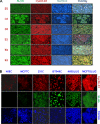
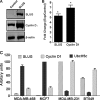
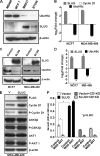
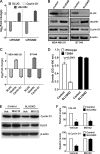
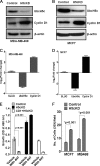

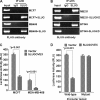

Similar articles
-
High motility of triple-negative breast cancer cells is due to repression of plakoglobin gene by metastasis modulator protein SLUG.J Biol Chem. 2012 Jun 1;287(23):19472-86. doi: 10.1074/jbc.M112.345728. Epub 2012 Apr 11. J Biol Chem. 2012. PMID: 22496452 Free PMC article.
-
TMPRSS4 induces invasion and proliferation of prostate cancer cells through induction of Slug and cyclin D1.Oncotarget. 2016 Aug 2;7(31):50315-50332. doi: 10.18632/oncotarget.10382. Oncotarget. 2016. PMID: 27385093 Free PMC article.
-
In vivo binding to and functional repression of the VDR gene promoter by SLUG in human breast cells.Biochem Biophys Res Commun. 2008 Jul 18;372(1):30-4. doi: 10.1016/j.bbrc.2008.04.187. Epub 2008 May 14. Biochem Biophys Res Commun. 2008. PMID: 18485278 Free PMC article.
-
The E2 ubiquitin-conjugating enzyme UbcH5c: an emerging target in cancer and immune disorders.Drug Discov Today. 2020 Sep 16:S1359-6446(20)30369-X. doi: 10.1016/j.drudis.2020.09.015. Online ahead of print. Drug Discov Today. 2020. PMID: 32947046 Review.
-
Degradation strategy of cyclin D1 in cancer cells and the potential clinical application.Front Oncol. 2022 Aug 18;12:949688. doi: 10.3389/fonc.2022.949688. eCollection 2022. Front Oncol. 2022. PMID: 36059670 Free PMC article. Review.
Cited by
-
Slug increases sensitivity to tubulin-binding agents via the downregulation of βIII and βIVa-tubulin in lung cancer cells.Cancer Med. 2013 Apr;2(2):144-54. doi: 10.1002/cam4.68. Epub 2013 Mar 1. Cancer Med. 2013. PMID: 23634282 Free PMC article.
-
High motility of triple-negative breast cancer cells is due to repression of plakoglobin gene by metastasis modulator protein SLUG.J Biol Chem. 2012 Jun 1;287(23):19472-86. doi: 10.1074/jbc.M112.345728. Epub 2012 Apr 11. J Biol Chem. 2012. PMID: 22496452 Free PMC article.
-
UBE2D3 is a positive prognostic factor and is negatively correlated with hTERT expression in esophageal cancer.Oncol Lett. 2015 Apr;9(4):1567-1574. doi: 10.3892/ol.2015.2926. Epub 2015 Feb 3. Oncol Lett. 2015. PMID: 25789002 Free PMC article.
-
Stromal SNAI2 Is Required for ERBB2 Breast Cancer Progression.Cancer Res. 2020 Dec 1;80(23):5216-5230. doi: 10.1158/0008-5472.CAN-20-0278. Epub 2020 Oct 6. Cancer Res. 2020. PMID: 33023950 Free PMC article.
-
A new role of SNAI2 in postlactational involution of the mammary gland links it to luminal breast cancer development.Oncogene. 2015 Sep 3;34(36):4777-90. doi: 10.1038/onc.2015.224. Epub 2015 Jun 22. Oncogene. 2015. PMID: 26096931 Free PMC article.
References
-
- López-Otín C., Hunter T. (2010) Nat. Rev. Cancer 10, 278–292 - PubMed
-
- Gallastegui N., Groll M. (2010) Trends Biochem. Sci. 35, 634–642 - PubMed
-
- Fang Y., Fu D., Shen X. Z. (2010) Biochim. Biophys. Acta 1806, 1–6 - PubMed
-
- Pickart C. M. (2001) Annu. Rev. Biochem. 70, 503–533 - PubMed
-
- Baek K. H. (2006) Curr. Protein Pept. Sci. 7, 171–177 - PubMed
Publication types
MeSH terms
Substances
Grants and funding
LinkOut - more resources
Full Text Sources
Medical
Research Materials
Miscellaneous

